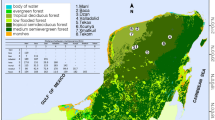Abstract
The globemallow,Sphaeralcea emoryi Torrey, a plant native to Arizona was evaluated as a source of feeding or oviposition deterrents to the boll weevil,Anthonomus grandis Boheman. Feeding and oviposition responses of reproductive weevils to the flower buds and artificial diets spiked with dry powder or extracts of the globemallow buds were determined. Boll weevils were deterred from feeding and ovipositing in the flower buds unless the calyxes were removed. Male and virgin female weevils were discouraged from feeding as much as gravid weevils. Secondary chemicals in the flower buds served primarily as feeding deterrents but also prevented oviposition. The concentration of these chemicals was highest in the calyxes of the buds, and potent deterrent activity could be extracted from the calyxes with methanol. Boll weevils were able to perceive the deterrents by contact chemosensory organs on the antennae, maxillary palps and labial palps.
Similar content being viewed by others
References
Bird, T.G., Hedin, P.A., andBurks, M.L. 1987. Feeding deterrent compounds to the boll weevil,Anthonomus grandis Boheman in rose of Sharon,Hibiscus syriacus, L.J. Chem. Ecol. 13:1087–1097.
Chapman, R.F. 1977. The role of the leaf surface in food selection by acridids and other insects.Coll. Int. Cent. Nat. Res. Sci. 265:133–149.
Cross, W.H., Lukefahr, M.J., Fryxell, P.A., andBurke, H.R. 1975. Host plants of the boll weevil.Environ. Entomol. 4:19–26.
Everett, T.R., andEarle, N.W. 1964. Boll weevil oviposition responses in cotton squares and various other substrates.J. Econ. Entomol. 57:651–656.
Everett, T.R., andRay, J.O. 1964. Observation of puncturing and oviposition behavior of boll weevils.J. Econ. Entomol. 57:121–123.
Fisher, D.C., andKogan, M. 1986. Chemoreceptors of adult Mexican bean beetles: External morphology and role in food preference.Entomol. Exp. Appl. 40:3–12.
Gast, R.T. 1965. Mass producing artificial diet pellets for adult boll weevil.J. Econ. Entomol. 59:173–176.
Maxwell, F.G., Parrot, W.L., Jenkins, J.N., andLafever, H.N. 1965. A boll weevil feeding deterrent from the calyx of an alternate host,Hibiscus syriacus.J. Econ. Entomol. 58:985–988.
Miles, D.H., Ly, A.M., Randle, S.A., Hedin, P.A., andBurks, M.L. 1987. Alkaloidal insect antifeedants fromVirola calophylla Warb.J. Agric. Food Chem. 35:794–797.
Miles, D.H., Chittawong, V., andPayne, A.M. 1990. Cotton boll weevil antifeedant activity and antifungal activity (Rhizoctonia solari andPythium ultimum) of extract of the stems ofWedelia biflora.J. Agric. Food Chem. 38:1591–1594.
Palumbo, J.C., Watson, T.F., andBergman, D.K. 1990. Globemallow,Sphaeralcea spp., as reproductive hosts for the boll weevil (Coleoptera: Curculionidae) in Arizona.J. Econ. Entomol. 83:392–397.
Parrot, W.L., Maxwell, F.G., andJenkins, J.N. 1966. Feeding and oviposition of the boll weevil,Anthonomus grandis (Coleoptera: Curculionidae) on the rose of Sharon, an alternate host.Ann. Entomol. Soc. Am. 59:547–550.
Pouzat, J. 1970. Role des organes sensoriels cephaliques dans l'ovogenese et l'emission chez la Bruche du HaricotAcanthoscelides obtecutus Say (Coleoptera: Bruchidae).Coll. Int. Cent. Nat. Res. Sci. 189:381–400.
Southwood, T.R.E. 1986. Plant surfaces and insects—an overview, pp. 1–22,in B. Juniper andT.R.E. Southwood (eds.). Insect and Plant Surface. Edward Arnold, London.
Stipanovic, R.D. 1983. Function and chemistry of plant trichomes and glands in insect resistance: protective chemicals in plant epidermal glands and appendages, pp. 69–100,in P.A. Hedin. (ed.). Plant Resistance to Insects. ACS Symposium Series 208, American Chemical Society, Washington, D.C.
Stoner, A. 1968.Sphaeralcea spp. as host of boll weevil in Arizona.J. Econ. Entomol. 61:1100–1102.
Szentesi, A. 1976. The effect of the amputation of head appendages on the oviposition of the bean weevil.Acanthoscelides obtecutus Say (Coleoptera: Bruchidae).Symp. Biol. Hun. 16:275–281.
Vanderzant, E., andDavich, T.B. 1961. Artificial diets for adult boll weevils and techniques for obtaining eggs.J. Econ. Entomol. 54:923–938.
Author information
Authors and Affiliations
Rights and permissions
About this article
Cite this article
Honda, H., Bowers, W.S. Feeding and oviposition deterrent activities of flower buds of globemallow,Sphaeralcea emoryi torrey, against boll weevil,Anthonomus grandis Boheman (Coleoptera: Curculionidae). J Chem Ecol 22, 139–150 (1996). https://doi.org/10.1007/BF02040205
Received:
Accepted:
Issue Date:
DOI: https://doi.org/10.1007/BF02040205




